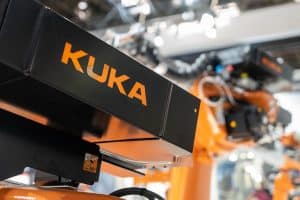If you’re building out an Elementary STEM program, you’re probably looking for ways to maximize your spending. Robots, coding, and building prototypes all require equipment and money to make happen. So with about $200 in total to spend, I set out on finding quality STEM kits under $40. Over the course of this article, I’m going to reveal my shopping list to you.
But, before I do that, I want to remind you that building up a STEM program doesn’t happen in one iteration. While you might already have a program (or you’re building a new one), don’t think that you can’t start off with lower-cost kits now and then expand on your program over time.
That’s why it’s important to pick kits that you can reuse and accessorize. This list is specifically for Elementary STEM programs. If you’re looking for a more generic list of STEM products for all ages, check out my resource guide.
1. Code-a-Pillar
The Code-a-Pillar by Fisher-Price is an introductory robotics toy for children under 8. Think of a caterpillar with a modular body. Each module snaps together and can be rearranged to move the caterpillar in various directions. When you press the “go” button on his back, he’ll move in the same order as the modules are snapped together.
This is a very simplistic way to teach children logic by setting up a “playing field” and making the Code-a-Pillar move through without touching or running into anything. You can also scale this activity for advanced learners by making it a time challenge or having students complete “X” number or variety of moves.
The Code-a-Pillar is a creative way to learn about directions, movement, and process flow. I recommend having at least 1 Code-a-Pillar per pair of students so that your classroom is more interactive. The nice thing about this option is that you don’t need a computer or anything else but 4 AA batteries to run a class with it.
You can also buy expansion packs for about $15 each that will enable the Code-a-Pillar to make silly sounds, basic moves, and master moves. It’s also worthy to note that there’s a Code-a-Pillar gift pack (over our $40 budget at $130) if you’d rather have an assortment of accessories for your Code-a-Pillar without having to put together the accessories yourself.
Now if you’d rather have an activity that is more appropriate for older elementary students (ages 10 and up), then you’ll want to check out #2, the OWI Hydraulic Arm Edge Kit.
2. OWI Hydraulic Arm Edge Kit
Students will have a blast building this robot arm while learning about hydraulics. Have no fear, the only thing you need to get this robot arm moving is water! Pretty cool, huh?!
[amazon box=”B01CTJ01PI” template=”list”]Discover hydro-mechanical technology and use the gripper to “vacuum” and lift objects. That means you don’t need batteries to get this kit to work! For more advanced learning, create lesson plans around degrees of freedom (DoF), since this robot has 6 Axes of movement. You can also use existing toys (Legos, Arts & Craft Supplies, etc.) to create objects to pick up. Lot’s of options when it comes to this robotic arm kit!
This is a building kit, so be ready to spend most of your time with this kit putting the arm together. The instructions are detailed, so students 12 and up should have no problem completing the activity independently or with a small group.
If you’re looking to show students how to use a screwdriver for building and assembly, this activity will give them hands-on experience. There are small parts with the kit, so this probably isn’t the best option for students under 8.
OWI also makes an RC version of this Robotic Arm, so if that interests you more, feel free to check it out!
Sometimes, you’re looking for something a little more “electrifying” for your summer camp program or STEM lesson. That’s where pick #3, Snap Circuits comes into play.
3. Snap Circuits: Build Your Own Electronic Circuits
Now, this kit is a steal at $22 each! You can get almost 2 kits for our $40 price point. Plus, there are a TON of accessories and add-on kits you can buy. But before we get into all of that, let’s talk a little bit about what you can do with Snap Circuits.
Snap Circuits is a modular electronics kit that allows you to build electrical circuits and devices. It’s the “LEGO’s” of circuit boards! Students can design and create devices using the components in this kit. The $22 Snap Circuits Jr set includes enough components to create over 100 different projects, which means your students will have plenty to play and learn with!
[amazon box=”B0002AHQWS,B008PEKYA4,B000GG7XXK,B06XC8T8GB” template=”list”]And, if over time, you’d like to expand your collection of Snap Circuits, you have plenty of options to do so. They make a 3D Illumination Kit, Snap Circuits Arcade Kit, and even a collection, Snapino, that is compatible with Arduino!
Once your students understand the fundamentals of electronic prototyping, the next step is to move them into computer programming with a microcontroller. Arduino is a great open-source (and low-cost) control board that is commonly used in robotics. There are endless possibilities of what you can do with Arduino, so you can’t go wrong starting here!
Out of all of the kits we’ve talked about, I haven’t included one that fully encompasses building and electronics for a simplified robotics kit. So, for my last recommendation, I’m going to give a shout-out to the Robotis Play 600 PETs Kit.
4. Robotis Play 600 PETs Kit
Last, but certainly not least, we have the Robotis Play 600 PETs Kit. This kit combines the power of an erector set (like LEGOs) with an electronic controller to command motors. While you cannot program this kit, the motorized controller brings designs to life. This particular kit has a pet theme, where you can build up to 7 different animals using their instruction booklet or 3D interactive app.
[amazon box=”B00U5XE1J8″ template=”list”]Rather than just talking about animals, you could have students build the animal and then determine how that animal moves, flies, or swims. This would make your lesson more interactive and hands-on! I speak a lot about how to make your robotics (and STEM) program successful and sustainable by including interactive lesson plans. This is a great way to incorporate that without breaking the bank!
There’s also an opportunity to create little habitats for these creatures using construction paper or arts & craft supplies. I like that this kit includes a motor because it’s a gentle way of showing students technology in an applied setting.
In addition to the PETs kit, Robotis also offers a dinosaur kit, which is also under $40. Depending on the theme or activity you’re trying to do, this might be a better fit!
Elementary STEM Kits under $40 Worth Buying
The biggest message I’m hoping you take away from this article is that STEM education can be affordable. You just need to find resources and kits that align with your goals and objectives as well as your budget. In this article, I outlined 4 Elementary STEM Kits under $40 worth buying.
[amazon box=”B01ASVD2L4,B01CTJ01PI,B0002AHQWS,B00U5XE1J8″ template=”list”]The cool thing about selecting any of these kits is that you can be creative with how you teach the lessons using them! With a little imagination, you can start off or enhance your STEM program on a budget of $40 per kit!
So, what do you think? Have you used any of these kits in your classes? Did I miss a really cool option that other teachers might like to try out? Leave a comment below!





